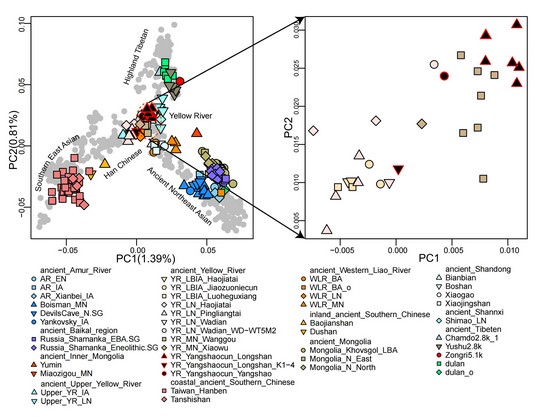HPICHA Scholars Published Paper to Explain Ancient Gene History of the Yangshaocun Site in Science Bulletin
Date Posted: 2024-09-05


Recently, scholars from Henan Provincial Institute of Cultural Heritage and Archaeology (HPICHA) and Xiamen University published online a research paper entitled “Ancient Genomic Time Transect Unravels the Population Dynamics of Neolithic Middle Yellow River Farmers” in Science Bulletin (English edition). By studying the genomes of ancient people in the naming place of the Yangshao Culture during the Yangshao Culture Period (5000 BC-3000 BC) and the Longshan Culture Period (3000 BC-1900 BC) at the Yangshaocun Site, this paper reveals the dynamic history of neolithic people along the middle reaches of the Yellow River in China.
Research on Ancient DNA at the Yangshaocun Site
Early in 1921, a team led by a Swedish geologist Johan G. Andersson, a mining adviser to the then Chinese Government, and a Chinese geologist Yuan Fuli, conducted the first excavation of the Yangshaocun Site in Mianchi County of Henan Province. They discovered a significant amount of Neolithic cultural artifacts and named it collectively as the Yangshao Culture. This discovery marked the beginning of modern archaeology in China. The Yangshaocun Site holds a significant place in the history of Chinese archaeology and the research history of the Yangshao Culture, but the knowledge about the origins of the ancient people at the Site and their contributions to the Chinese nation is limited. The analysis of paleogenetic data from the Yangshaocun Site will enhance people’s understanding of China’s ethnographic history in the middle reaches of the Yellow River during the Neolithic period (7000 BC-1700 BC).
Researchers from the HPICHA and Xiamen University sampled, extracted, and sequenced the ancient DNA from the Yangshaocun Site, and published the first ancient genomic data on eight individuals from the Yangshaocun Site, who belonged to the Yangshao and Longshan Cultures of the Neolithic Period (7000 BC-1700 BC). Their research has also discovered a significant level of genetic continuity between the Yangshao Culture of the Yangshaocun Site and the populations from the Longshan Culture, which played a crucial role in the genetic makeup of the Chinese nation. For instance, 57%-92% of the genetic components in Chinese populations of Han ethnic group across different regions can be traced back to the ancient populations in the middle reaches of the Yellow River during the Neolithic era, particularly the ancient inhabitants of the Yangshaocun Site. This percentage is also notably high, ranging from 70%-80% in Tibetan populations residing in southwest China’s Xizang Autonomous Region. Additionally, a considerable number of populations from the Hmong-Mien and Kra-Dai languages in South China have inherited a significant portion of the genetic lineages from the ancient people of the middle reaches of the Yellow River during the Neolithic era.

Principal Component Analysis (PCA) of Yangshaocun Site Samples with Ancient and Modern Populations in East Asia
Previous researches have shown that the ancient populations at the Wadian Site in Yuzhou City, the Haojiatai Site in Luohe City and Pingliangtai Site in Huaiyang City all belonged to the Longshan Culture of Henan Province with genetic homogeneity. Compared to the populations from the Yangshao Culture in the middle reaches of the Yellow River, these populations received genetic influences from the southern region of East Asia. However, researchers found that this gene flow did not affect the contemporaneous populations in the nearby area, the Yangshaocun Site belonging to the Longshan Culture ancients. Finally, this paper found that some individuals from the Yangshaocun Site belonging to the Longshan Culture were influenced by the ancient Northeast Asian gene flow. The Yangshaocun Site’s populations during the Longshan Period can be modeled as a mixture of the Yangshao Culture-related ancestry and the ancient Northeast Asian ancestry, and they are relatively genetically homogeneous with the populations at the Shimao Site in Northwest China’s Shanxi Province. The appearance of ancient Northeast Asian-related ancestry in the middle reaches of the Yellow River may be related to the cultural influence of the Hetao region on the Yellow River basin during the Longshan Period. In addition, some individuals from the Yangshaocun Site of Longshan Culture and one individual from the Wadian Site can be modeled as direct descendants of the population in the Yangshao Culture. It is still not clear why these ancient individuals did not receive gene flows from the southern region of East Asia and Northeast Asia like other contemporaneous individuals did.

Analysis of the Genetic Composition of the Yangshaocun Site Samples
This study has filled in some of the gaps in China’s ancient genomic data of the Neolithic populations in the middle reaches of the Yellow River, playing an important role in understanding the history of Neolithic populations in the middle reaches of the Yellow River as well as the origins and spread of Chinese civilization.

First page of Paper Published
— 《Science Bulletin》 —
Science Bulletin (English edition)
The Science Bulletin is a leading journal of the Excellence Action Plan for China’s STM Journals sponsored by the Chinese Academy of Sciences and the National Natural Science Foundation of China. It is a Tier-1 TOP journal of the Chinese Academy of Sciences and a Tier-1 journal in the Journal Citation Reports (JCR), with an impact factor of 18.8, ranking in the top five in the field of international interdisciplinary research.
Research Team
Li Shiwei from the HPICHA, and Wang Rui and Ma Hao, Ph.D. candidates from Xiamen University School of Life Sciences, are the co-first authors of the paper, while the HPICHA’s Researcher Wei Xingtao and Professor Wang Chuanchao from Xiamen University Institute of Anthropology are the co-corresponding authors of the paper.
This research was funded by Henan Provincial Philosophy and Social Sciences Planning Project, Henan Province Research Project on Cultural Prosperity, the Project of the National Science Fund for Distinguished Young Scholars, the Major Project of the National Social Science Fund and the General Project of National Natural Science Foundation of China.

Scan the QR code above to view the original paper.







